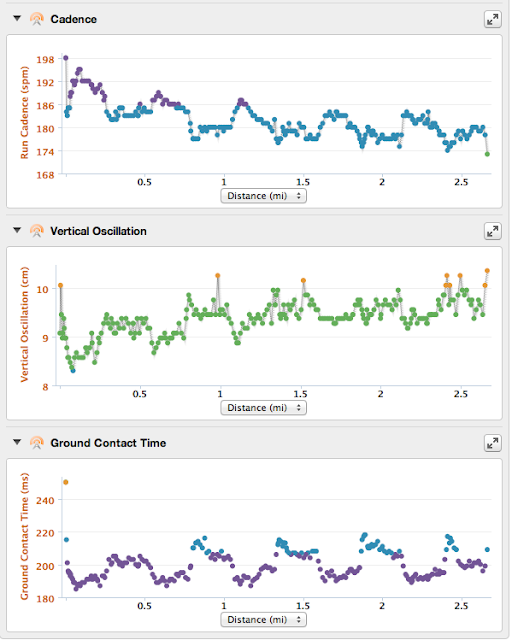Forerunner 620: First Thoughts
I was so ridiculously overexcited about getting my paws on this gadget of gadgets. I'm the kind of runner who loves nothing more than analysing her run to within an inch of its life. So far this has involved pace, elevation, distance, time and heart rate. I would look (in disappointed annoyance) at the declining pace as the ground tilted skywards and sigh. If only I could see why I was so bad at going up hills compared to my training buddies…
Then came the Forerunner 620 and its running dynamics. Now I could analyse what I was actually doing when the ground stopped being conveniently flat. Unfortunately it looks like my running dynamics actually improve when I go uphill…
The running dynamics measured by the Forerunner 620 include:
Vertical oscillation: how much you go up and down
Cadence: how many steps you take per minute
Ground contact time: how long your foot is on the ground
The watch also calculates your recovery time and VO2 max (and from that your predicted race times)
Here's what the 620 thought of the first of 2 10*400m sets (alternating pace between 85 and 95(ish))
Then came the Forerunner 620 and its running dynamics. Now I could analyse what I was actually doing when the ground stopped being conveniently flat. Unfortunately it looks like my running dynamics actually improve when I go uphill…
The running dynamics measured by the Forerunner 620 include:
Vertical oscillation: how much you go up and down
Cadence: how many steps you take per minute
Ground contact time: how long your foot is on the ground
The watch also calculates your recovery time and VO2 max (and from that your predicted race times)
Here's what the 620 thought of the first of 2 10*400m sets (alternating pace between 85 and 95(ish))
The Running Dynamics are colour coded with Purple as the sweet zone (I don't know how Garmin came up with this data, they just say from elite athletes…), blue as okay, green is okayish, orange is not good and red is bad. Basically a rainbow of elite to beginner.
Cadence: In every run I've done with the Forerunner 620 (Fred from here on) my cadence starts off well and drops as I tire. So this is definitely something I can work on.
Ground Contact Time: I think this has to be treated very carefully. The faster I am running the shorter the ground contact time. Most of Garmin's research has been on elite athletes, who are obviously going to be running at a lick. So I'm not convinced that there is much to be gained from this from a training point of view. However, when it comes to choosing running shoes this could be a big one. In my clumpier, medium stability shoes I have a longer GCT at any speed than I do in my Inov8 bare road shoes and again my new Brooks Pureflow (I'm in love) also reduce my GCT. Both the Inov8s and the Brooks encourage a midfoot strike. So wearing your Fred on the running store treadmill might be better than watching video feedback of you running.
Vertical Oscillation: This has highlighted a 'problem'. I spend far too much time (according to Fred) going up and down when I should be focused on propelling myself forwards. The question is, is this really a problem or am I just a Tigger runner. Is vertical oscillation just a necessary and natural part of the way I run? The key here is perhaps change over time rather than the apparently excessive bounce. I do bounce up and down more as I tire. So that aspect is worth pursuing. I mentioned it to my coach though and he said 'don't get tired then', The other thing to note is the basic maths of going up and down hills: going up will naturally reduce your bounce as each step is dropping you a little less compared to where you were and going down will accentuate the oscillation as you have to drop further on each step just to hit the ground. Unfortunately this undermined my initial joy of discovering my great uphill technique…
Some of these issues are illustrated when you compare the 2 sets, the warm up and recovery:
The two sets are remarkably similar overall but the difference between the dynamics of the warm up and the recovery are interesting. I was taking fewer steps per minute and spending more time going up and down with a longer GCT. Surprisingly the stride length is longer in the recovery jog, perhaps carried over from the speed work.
Finally, an easy run (in new Brooks Pureflow):
The elevation profile (short flat, undulating, up, long shallow down, short up, long shallow up) is reflected in both the Vertical Oscillation and the GCT (the two long stretches in the middle). There is though a definite trend towards less economic running over time…
The final two new features of the 620 (or Fred) are the VO2 max calculation and the recovery advisor. Both need to measure you for a while before they come into their own. My Vo2 max race predictor calculation is still short of my recent race times (recent 5K off road 19.17, predicted road is only 19.35) but it inches up every time I run. The recovery advisor on the other hand is altogether more problematic if you train with a group. I have a schedule to follow, so being told I haven't recovered from a previous session isn't hugely helpful. However. as yet, it has always told me I'm ready to go hard on training nights. I suspect this speaks more to the genius of Ron Morrison's training plans than anything else.
You can pick up a Fred of your own from Wiggle Online Cycle Shop or from Amazon:







Comments